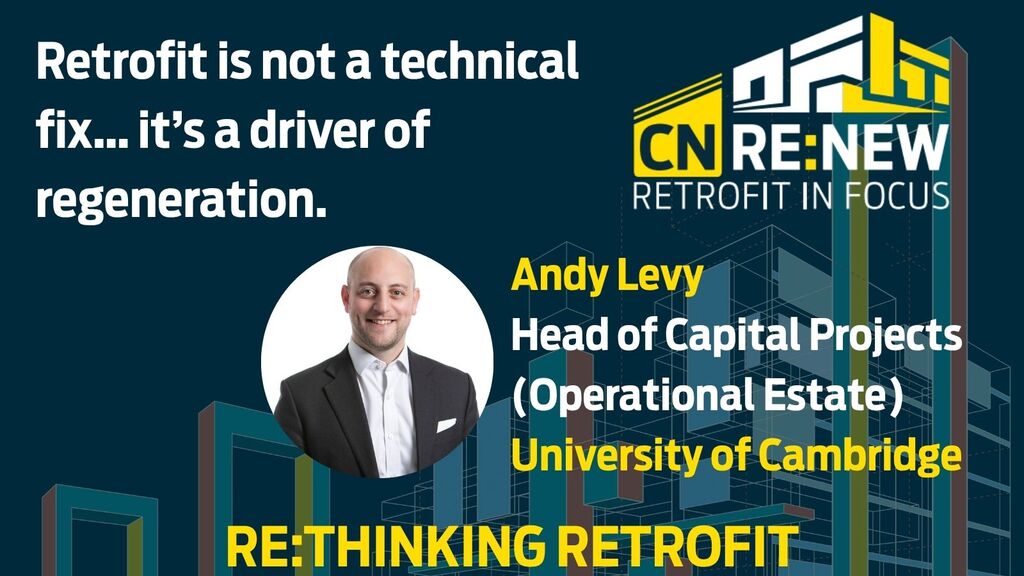
Retrofit is not a technical fix… it’s a driver of regeneration.
As the UK edges closer to its 2050 net zero target, the retrofit agenda has shifted from aspiration to imperative.
More than 80% of the buildings that will stand in 2050 are already built. That reality makes retrofit not an option, but a necessity. The challenge is clear: we must transform our existing stock to meet future environmental, social and economic demands.
That’s why the inaugural CN RE:NEW Retrofit in Focus 2025 conference is so timely.
Bringing together leaders from across construction, engineering, housing, and government to tackle the retrofit challenge head-on is vital.
At CN RE:NEW 2025 I’m excited to be hosting a session titled “Retrofit and Regeneration: Stories and Solutions”, which will explore how successful projects have leveraged early partnership to deliver high-quality, high-performance results. We will showcase examples that prove deep retrofit, done right, delivers superior social, environmental, and financial value and can be a catalyst for wider urban renewal.
The conference programme includes sessions on financing retrofit, digital innovation, and sector-specific case studies - from life sciences hubs to public housing estates. It’s a chance to learn from those who are already delivering, and to understand the barriers that still need to be overcome.
I believe that we must shift our mindset from viewing existing buildings as liabilities to seeing them as vast banks of materials and embodied carbon waiting to be unlocked. Treating existing fabric as a valuable, reusable asset must become the benchmark for 'what good looks like'. It ensures we conserve embodied carbon while optimising operational performance, embedding both sustainability and quality through the project process.
The success of retrofit hinges on collaboration. Clients (whether local authorities or commercial developers) must engage with the supply chain much earlier. Design teams and contractors need to collaborate on constructability, logistics, and material sourcing at the earliest opportunity. It also needs data-driven asset management and flexible procurement approaches that reward innovation, not just lowest cost.
Refurbishments also provide the opportunity to reduce emissions. As part of the University of Cambridge’s commitments to reduce our overall carbon emissions, specifically our commitment to reducing energy-related emissions from our operational estate to absolute zero carbon by no later than 2048, we are transforming how our buildings use energy.
Over the last few years, we have been investing in low-carbon retrofits of our existing buildings. These upgrades focus on reducing energy use and replacing fossil fuel systems with cleaner, more efficient technologies. These include Photovoltaic (PV) panels on our buildings to generate clean electricity and heat pump projects. Switching from fossil fuel gas-fired heating systems to efficient electric heat pumps, especially when combined with fabric upgrades (improvements to the building’s physical structure to reduce heat demand), delivers a substantial reduction in building-related emissions.
Our projects demonstrate how targeted investment in existing buildings can support both our sustainability commitments and modern building performance, ensuring we continue to reduce carbon emissions while meeting the diverse needs of our University community.
However, we also need to shift the narrative—from retrofit as a technical fix to retrofit as a driver of regeneration. The Government has committed £9.2 billion to improve energy efficiency in homes and public buildings, but funding alone won’t solve the problem. We need joined-up thinking, consistent standards, an engaged supply chain and a skilled workforce.
Retrofitting at the scale Britain needs will demand more than isolated exemplars. To ensure success we need collaboration, innovation and delivery at scale. It will require consistent policy certainty, supply chain investment, and shared digital infrastructure. Above all, it needs the belief that improving what exists is not second best - it’s the most sustainable path forward.
If we’re serious about net zero, we must move from pilot projects to portfolio-wide strategies. From compliance to creativity. From carbon counting to community building.
